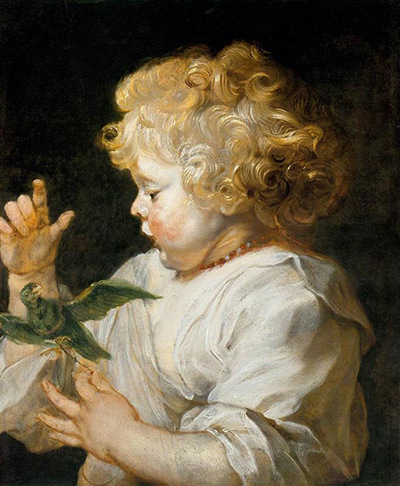Boy With Bird, measuring forty-nine centimetres by forty centimetres, is an oil-on-panel portrait of an infant male who holds a captive bird in one hand.
The boy, seen in profile and believed to be the Flemish painter’s first son, clasps a cord between his forefinger and his thumb that is tied to the bird’s leg while the bird spreads its wings and looks back at its captor in protest. It is possible that the bird, with dark feathers and a yellow beak, is a common starling but it could also be a male blackbird.
The painting, executed in 1616, is on display at the Staatlich Museen in Berlin.
It is believed that Rubens created the painting as part of a study for Madonna In Floral Wreath, completed in 1620, that featured the Virgin Mary and the Infant Christ surrounded by a host of cherubs. Western artistic tradition dictated that cherubs, or angelic beings that are mentioned in the Judaeo-Christian scriptures, should be depicted as infant children and Renaissance artists modelled their cherubs on real life children.
The Flemish painter’s son, being two at the time of the portrait’s composition, possessed the type of cherubic features that would be useful in the study.
The boy, possessing a shock of blonde curls, is wearing a white shirt that appears to be fashioned from either silk or the finest quality linen. White is a known symbol of purity and, in the context of this painting, could represent the innocence of children. A necklace of white and red beads is worn around the child’s neck and red, within the Northern artistic tradition, represented the Virgin Mary’s robe. An expression of wonderment and of amusement is worn on the boy’s face, whose pale cheek is tinged with a hint of rouge, and this stands in contrast to the bird’s indignant expression.
It is thought that the bird in the portrait represents the immortal soul, bound in flesh for a brief time, and that the child’s tentative grip on the animal represents the fleeting quality of life. The child holds the bird captive, his shirt sleeve rolled up to the elbow of the arm with which he pinches the cord, but will have to release the animal in the near future just as the body must surrender the soul. In a more literal sense it could be assumed that it was common practice, in seventeenth century Flanders, for parents to amuse their children with captive animals.




